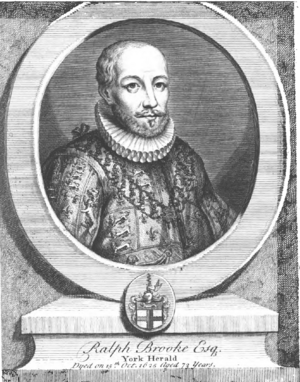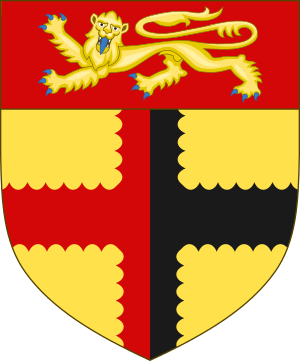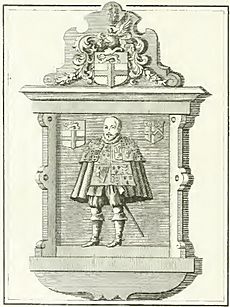Ralph Brooke facts for kids
Ralph Brooke (born 1553, died 1625) was an English Officer of Arms. This means he was an expert in heraldry, which involves coats of arms and family histories. He worked for Queen Elizabeth I and King James I.
Brooke is well-known for criticizing the work of other people at the College of Arms, where heralds worked. He wrote a book called A Discoverie of Certaine Errours Published in Print in the Much Commended 'Britannia' 1594. This book pointed out mistakes in a famous work by William Camden, a respected historian. This led to a big disagreement between them.
Contents
Early Life and Family
Ralph Brooke said his father was Geoffrey Brooke, who came from a noble family in Lancashire. However, records from the Merchant Taylors' School, where Ralph studied, simply state that his father, Geoffrey, was a shoemaker.
Ralph Brooke's Career and Disagreements
Ralph Brooke started his career as a Rouge Croix Pursuivant in 1580. This was a junior role in the College of Arms. Later, in 1593, he became a York Herald. As York Herald, he had an important role in the funeral procession of Queen Elizabeth I. He carried the helm (helmet) and crest (the part on top of a helmet in a coat of arms) during the ceremony.
In 1597, Brooke published his book, A Discoverie of Certaine Errours Published in Print in the Much Commended 'Britannia' 1594. This book caused a strong argument with William Camden, who wrote the original Britannia.
Brooke also challenged the work of other heralds. In 1602, he accused Sir William Dethick, who was the Garter King of Arms (the chief herald), and William Camden. Brooke claimed they had wrongly given coats of arms to 23 "ordinary" men. One of these men was John Shakespeare, the father of the famous playwright William Shakespeare.
In 1614, Brooke complained that Robert Cooke, another herald, had given out more than 500 new coats of arms. He also said that Sir Gilbert Dethick and his son Sir William had given out even more. These kinds of arguments and rivalries were common among the heralds at that time. Another herald, Sir William Segar, also said that Cooke gave many coats of arms to "unworthy people" just to make money.
A Clever Trick
In December 1616, Brooke played a trick on Sir William Segar. He made Segar confirm foreign royal coats of arms to a common hangman from London named Gregory Brandon. Brandon was pretending to be a gentleman. After Segar confirmed the arms, Brooke told King James I about the trick. The King was not pleased and sent both Brooke and Segar to a prison called Marshalsea. They were released a few days later. The Lord Chamberlain (a high-ranking official) hoped this experience would make Brooke more honest and Segar more careful.
Ralph Brooke's Books
Brooke wrote a book called Catalogue and Succession of the Kings, Princes, Dukes, Marquesses, Earles and Viscounts of this Realme of England since the Norman Conquest. It was published in 1619. A new version of his Discoverie book came out in 1622. It included Camden's reply and Brooke's response. In the same year, an updated version of his Catalogue and Succession book was also released, covering events up to 1622.
Ralph Brooke passed away on October 16, 1625. He was buried inside St Mary's Church, Reculver. A black marble tablet was placed on the church wall to remember him. It showed him wearing his herald's tabard, which is a special coat worn by heralds.





